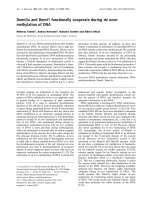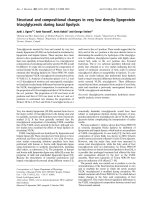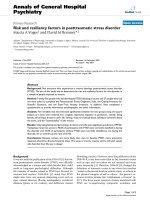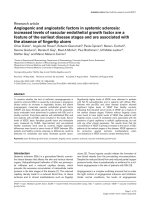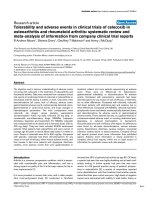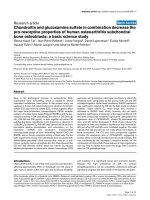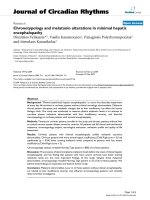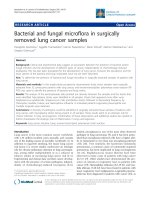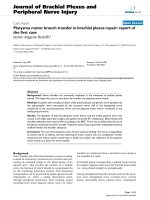Báo cáo y học: "Angiogenic and angiostatic factors in systemic sclerosis: increased levels of vascular endothelial growth factor are a feature of the earliest disease stages and are associated with the absence of fingertip ulcers" doc
Bạn đang xem bản rút gọn của tài liệu. Xem và tải ngay bản đầy đủ của tài liệu tại đây (80.38 KB, 10 trang )
Introduction
Systemic sclerosis (SSc) is a generalized fibrotic connec-
tive tissue disease that affects the skin and various internal
organs. Histopathological hallmarks of SSc are perivascu-
lar infiltrates and a reduced capillary density, which
precede the excessive accumulation of extracellular matrix
proteins in the later stages of the disease [1]. The reduced
capillary density leads to a reduced blood flow, to tissue
ischemia and to clinical manifestations such as fingertip
ulcers [2]. Tissue hypoxia usually initiates the formation of
new blood vessels from the pre-existing microvasculature.
Despite the reduced blood flow and reduced partial oxygen
pressure levels, there is paradoxically no evidence for a suf-
ficient angiogenesis in the skin of patients with SSc [3].
Angiogenesis is a complex multistep process that is under
the tight control of angiogenesis inducers and inhibitors.
Under normal conditions, the levels of angiogenesis
bFGF = basic fibroblast growth factor; ELISA = enzyme-linked immunosorbent assay; SSc = systemic sclerosis; VEGF = vascular endothelial
growth factor.
Available online />Research article
Angiogenic and angiostatic factors in systemic sclerosis:
increased levels of vascular endothelial growth factor are a
feature of the earliest disease stages and are associated with
the absence of fingertip ulcers
Oliver Distler
1
, Angela del Rosso
2
, Roberto Giacomelli
3
, Paola Cipriani
3
, Maria L Conforti
2
,
Serena Guiducci
2
, Renate E Gay
1
, Beat A Michel
1
, Pius Brühlmann
1
, Ulf Müller-Ladner
4
,
Steffen Gay
1
and Marco Matucci-Cerinic
2
1
Center of Experimental Rheumatology, Department of Rheumatology, University Hospital Zurich, Switzerland
2
Department of Medicine, Section of Rheumatology, University of Florence, Italy
3
Department of Internal Medicine and Public Health, University of L’Aquila, Italy
4
Department of Internal Medicine I, University of Regensburg, Germany
Corresponding author: Steffen Gay (e-mail: )
Received: 14 May 2002 Revisions received: 30 July 2002 Accepted: 6 August 2002 Published: 30 August 2002
Arthritis Res 2002, 4:R11 (DOI 10.1186/ar596)
© 2002 Distler et al., licensee BioMed Central Ltd (Print ISSN 1465-9905; Online ISSN 1465-9913)
Abstract
To examine whether the lack of sufficient neoangiogenesis in
systemic sclerosis (SSc) is caused by a decrease in angiogenic
factors and/or an increase in angiostatic factors, the potent
proangiogenic molecules vascular endothelial growth factor
(VEGF) and basic fibroblast growth factor, and the angiostatic
factor endostatin were determined in patients with SSc and in
healthy controls. Forty-three patients with established SSc and
nine patients with pre-SSc were included in the study. Serum
levels of VEGF, basic fibroblast growth factor and endostatin
were measured by ELISA. Age-matched and sex-matched
healthy volunteers were used as controls. Highly significant
differences were found in serum levels of VEGF between SSc
patients and healthy controls, whereas no differences could be
detected for endostatin and basic fibroblast growth factor.
Significantly higher levels of VEGF were detected in patients
with Scl-70 autoantibodies and in patients with diffuse SSc.
Patients with pre-SSc and short disease duration showed
significant higher levels of VEGF than healthy controls,
indicating that elevated serum levels of VEGF are a feature of
the earliest disease stages. Patients without fingertip ulcers
were found to have higher levels of VEGF than patients with
fingertip ulcers. Levels of endostatin were associated with the
presence of giant capillaries in nailfold capillaroscopy, but not
with any other clinical parameter. The results show that the
concentration of VEGF is already increased in the serum of SSc
patients at the earliest stages of the disease. VEGF appears to
be protective against ischemic manifestations when
concentrations of VEGF exceed a certain threshold level.
Keywords: basic fibroblast growth factor, endostatin, fingertip ulcers, systemic sclerosis, vascular endothelial growth factor
Page 1 of 10
(page number not for citation purposes)
Page 2 of 10
(page number not for citation purposes)
Arthritis Research Vol 4 No 6 Distler et al.
inducers and inhibitors are balanced and angiogenesis
does not occur in healthy tissues. In a hypoxic environ-
ment and in inflammatory states such as rheumatoid arthri-
tis, angiogenic growth factors are induced and outweigh
the inhibitors, resulting in the initiation of angiogenesis [4].
Among the angiogenesis inducers, vascular endothelial
growth factor (VEGF) and basic fibroblast growth factor
(bFGF) have been characterized as key molecules in the
induction of angiogenesis. VEGF is involved in several
steps of physiological and pathological angiogenesis
including proliferation, survival and migration of endothelial
cells. The biological effects of VEGF are extremely dose
dependent. Loss of even a single allele results in lethal
vascular defects in the embryo, and postnatal inhibition of
VEGF leads to impaired organ development and growth
arrest in mice [5–7]. Application of VEGF as a recombi-
nant protein or by gene transfer augmented perfusion and
development of collateral vessels in animal models of
hindlimb ischemia, thereby making VEGF an interesting
target for therapeutic angiogenesis [8,9].
In contrast to VEGF, genetic loss of bFGF does not cause
major vascular defects and bFGF has no exclusive speci-
ficity for endothelial cells. However, bFGF has been
shown to stimulate proliferation, migration and differentia-
tion of endothelial cells and it synergies potently with
VEGF in its angiogenic actions. Similar to VEGF, bFGF
stimulates angiogenesis in different animal models for
ischemic diseases [10,11].
Endostatin is a C-terminal, 20 kDa fragment of the base-
ment protein collagen type XVIII. Endostatin inhibits angio-
genesis and tumor growth strongly by reducing
endothelial cell proliferation and migration [12]. Recent
data suggest that cathepsin L is involved in the cleavage
of endogenous endostatin from perivascular collagen type
XVIII [13]. Although the mechanisms of action are not fully
elucidated, it has been shown that endostatin inhibits the
proteolytic activation of pro-matrix metalloproteinase-2 and
the catalytic activities of membrane type 1 matrix metallo-
proteinase and matrix metalloproteinase-2 [14].
Angiogenesis is strongly disturbed in SSc, as demon-
strated by nailfold capillaroscopy changes. Capillary
dropouts can often be found in later stages of the disease.
Before this endpoint, however, angiogenesis appears to
be disturbed at different levels, and a variety of morpho-
logical changes can be detected (e.g. megacapillaries,
bushy capillaries). The modification of the angiogenic
process is thus contributing to the chronically reduced
oxygen supply of the tissue, resulting in ischemic manifes-
tations such as fingertip ulcers [15].
The lack of a sufficient response to hypoxia and other
stimuli to form functional vessels in patients with SSc
might be explained by an inappropriate synthesis of angio-
genic factors or an inhibition by angiostatic factors. The
aim of the present study was to analyze whether a
decrease of the angiogenic factors VEGF and bFGF and
an increase of the angiostatic factor endostatin contribute
to the impaired angiogenesis in patients with SSc, and
whether these factors may correlate with the main clinical
features and parameters of vascular involvement.
Materials and methods
Patients
Forty-three consecutive patients with SSc were recruited
at the Section of Rheumatology of the University of
Florence. All patients fulfilled the American College of
Rheumatology criteria for SSc [16]. There were 35 women
and eight men with a median age of 61 years (range,
24–79 years). Patients with overlap symptoms to other
connective tissue diseases were excluded from the study.
Nine patients without skin involvement were included to
assess the levels of angiogenesis-related molecules in a
prescleroderma condition [17]. These patients presented
with Raynaud’s phenomenon, nailfold capillaroscopy
changes and circulating autoantibodies characteristic for
SSc (anti-topoisomerase I, anticentromere or antinuclear
with nucleolar pattern). The nine pre-SSc patients were all
female, with a median age of 58 years (range, 32–70 years).
Healthy volunteers (n = 21) were used as controls. The
control group consisted of 16 women and five men with a
median age of 55 years (range, 29–96 years). An addi-
tional control group (n = 20) was used for the endostatin
measurements, consisting of 17 women and three men
with a median age of 49 years (range, 23–69 years). All
patients and controls were of Caucasian origin.
Clinical assessment
An extensive clinical profile was established for each pre-
SSc patient and each SSc patient. Patients’ characteris-
tics are summarized in Table 1.
SSc patients were classified as affected by limited SSc or
by diffuse SSc according to the criteria proposed by
LeRoy et al. [18]. Disease stages were defined as sug-
gested by Medsger and Steen [19]: early limited SSc,
disease duration < 5 years; intermediate/late limited SSc,
disease duration ≥ 5 years; early diffuse SSc, disease
duration < 3 years; and intermediate/late SSc, disease
duration ≥ 3 years.
The presence of fingertip ulcers at the time of blood
drawing, other skin ulcers (e.g. at the lower extremities,
elbows, forearms), teleangiectasias and disease duration
since first nonRaynaud symptoms were recorded. All
patients reported the occurrence of Raynaud’s phenome-
non after exposure to low temperatures. The modified
Page 3 of 10
(page number not for citation purposes)
Rodnan skin score was assessed by an experienced
rheumatologist at 17 body areas by clinical palpation and
was rated 0–3, with a maximum total score of 51 [20].
Nailfold videocapillaroscopy was performed in a blinded
manner for the analysis of microvascular abnormalities.
Patients were allowed to adapt to room temperature
(20–22°C) for at least 15 min before the examination was
started. The nailfolds of all 10 fingers were analyzed for
the following parameters: presence of enlarged and giant
capillaries, pericapillary edema, hemorrhages, loss of
capillaries, ramified/bushy capillaries and disorganization
of the vascular distribution.
According to these analyzed features, patients were
grouped into capillaroscopy changes with an early, active
and late pattern using the criteria proposed by Cutolo et
al. [21]. The early pattern included the criteria of few giant
capillaries and capillary hemorrhages, relatively well
preserved capillary distribution and no evident loss of
capillaries. The criteria for the active pattern were frequent
capillary hemorrhages and giant capillaries, moderate loss
of capillaries with some avascular areas, mild disorganiza-
tion of the capillary architecture and absent or some rami-
fied capillaries. Finally, the late pattern criteria were
irregular enlargement of capillaries, few or absent giant
capillaries, absence of hemorrhages, severe loss of capil-
laries with large avascular areas, severe disorganization of
the normal capillary distribution and frequent ramified/
bushy capillaries.
Pulmonary involvement was examined by the carbon
monoxide diffusion capacity using the single-breath
method standardized for hemoglobin.
Antinuclear antibodies were determined by ELISA, anti-
centromere antibodies determined on Hep-2 cells and
anti-topoisomerase I (Scl-70) antibodies were determined
by immunoblot analysis.
Concomitant treatment of SSc patients included
angiotensin-converting enzyme inhibitors, calcium channel
blockers, proton-pump inhibitors, clebopride and topical
glyceryl trinitrate. Patients with pre-SSc were treated with
calcium channel blockers and topical glyceryl trinitrate. All
patients had received therapy with intravenous prosta-
noids. None of the study patients received corticosteroids,
methotrexate, cyclophosphamide,
D-penicilliamine or other
potentially disease-modifying drugs.
ELISA for VEGF, bFGF and endostatin
After signed consent, blood samples were drawn from
patients as well as from healthy controls from the ante-
cubital vein, between 8:00 and 9:00 a.m. Samples were
centrifuged, and the obtained sera were stored in aliquots
at –20°C until analyses.
Levels of VEGF and bFGF protein were determined by
quantitative colorimetric sandwich ELISA (R&D Systems,
Abingdon, UK) according to the manufacturer’s instruc-
tions. Concentrations were calculated using a standard
curve generated with specific standards provided by the
manufacturer.
The ELISA for VEGF recognizes human VEGF
165
with
crossreactivity to VEGF
121
, but not to factors related to
VEGF such as human placental growth factor and platelet-
derived growth factor. Interassay and intra-assay variances
were less than 10%. The minimum detectable concentra-
tion of VEGF was less than 9.0 pg/ml.
Available online />Table 1
Clinical characteristics of systemic sclerosis (SSc) patients,
patients with pre-SSc and healthy controls
SSc Pre-SSc Healthy
Characteristic (n = 43) (n = 9) (n = 21)
Age (years), median (range) 61 58 55
(24–79) (32–70) (29–96)
Gender
Male 8/43 0/9 5/21
Female 35/43 9/9 16/21
Disease subset
Diffuse 23/43 –
Limited 20/43 –
Disease phase
Early 25/43 –
Intermediate/late 18/43 –
Fingertip ulcers
Positive 16/43 –
Negative 27/43 –
Other skin ulcers
Positive 18/43 –
Negative 25/43 –
Skin score
Diffuse SSc, median (range) 22 (4–45) –
Limited SSc, median (range) 11 (4–30) –
Capillaroscopy
Early 6/43 1/9
Active 22/43 7/9
Late 14/43 0/9
No changes 1/43 1/9
Autoantibodies
Antinuclear antibody-positive 39/43 9/9
Anti-Scl-70 autoantibody-positive 13/43 0/9
Anticentromere antibody-positive 11/43 7/9
No autoantibodies 4/43 0/9
Carbon monoxide diffusion 70 (26–144) –
capacity (%), median (range)
See text for definitions.
The assay for bFGF showed minimal crossreactivity to
FGF-4 (0.02%), but not to other factors related to bFGF
such as acidic fibroblast growth factor. The minimal
detectable concentration of bFGF in serum was less than
3 pg/ml, and the interassay and intra-assay variances were
less than 10%.
The serum levels of the free form of human endostatin
were determined by quantitative colorimetric sandwich
ELISA (CytElisa Human Endostatin; CytImmune, College
Park, MD, USA) according to the manufacturer’s instruc-
tions. Concentrations were calculated using a standard
curve generated with specific standards provided by the
manufacturer. The assay did not show any crossreactivity
with World Health Organization standards for any human
and murine cytokine, including murine endostatin. The
minimum detectable concentration of endostatin was less
than 12 pg/ml, and the interassay and intra-assay vari-
ances were less than 10%.
Statistical analysis
Data are shown as box plots with median and upper and
lower quartiles if not otherwise indicated. The Kruskal–
Wallis test was used for analysis of differences between
more than two groups, and the Mann–Whitney test was
used for subanalysis between two specific groups. For
comparison of continuous variables, the Spearman’s rank
test was applied. P < 0.05 was considered of statistical
significance.
Results
Circulating levels of VEGF
Highly significant differences were found in serum levels
of VEGF between patients with SSc (median, 412 pg/ml;
range, 93–1151 pg/ml) and age-matched and sex-
matched healthy controls (median, 101 pg/ml; range, not
detectable–377 pg/ml; P < 0.001), as illustrated in
Fig. 1a.
When analyzed according to the disease subset, both
patients with diffuse SSc as well as patients with limited
SSc showed significantly increased levels of VEGF com-
pared with healthy controls (P < 0.001) (Fig. 1b). In addi-
tion, patients with diffuse disease (median, 442 pg/ml;
range, 93–1151 pg/ml) showed significantly higher levels
of VEGF than patients with limited disease (median,
283 pg/ml; range, 135–826 pg/ml; P ≤ 0.02).
Circulating levels of endostatin and bFGF
In contrast to VEGF, median values of endostatin were not
increased in SSc patients (18.0 ng/ml; range, not
detectable–750 ng/ml) compared with healthy controls
(median, 22.5 ng/ml; range, 6–250 ng/ml) (Fig. 2a). Levels
of endostatin were not different between patients with
diffuse SSc (median, 18 ng/ml; range, not detectable–
750 ng/ml) and patients with limited SSc (median,
20 ng/ml; range, 4–650 ng/ml; P = 0.75). Levels of bFGF
were not detectable in the majority of patients with SSc
(n = 27/43, 63%) and in healthy controls (n = 5/7, 71%)
(Fig. 2b).
Arthritis Research Vol 4 No 6 Distler et al.
Page 4 of 10
(page number not for citation purposes)
Figure 1
(a) Serum levels of vascular endothelial growth factor (VEGF) in
patients with established systemic sclerosis (SSc) and in healthy
controls. Data are shown as box plots, with upper and lower quartiles
shaded. Highly significant differences were found for serum levels of
VEGF compared with healthy controls. (b) Serum levels of VEGF
analyzed according to the disease subset. Patients with diffuse SSc
showed significant higher levels of VEGF than did patients with limited
SSc.
#
P < 0.05.
2143n =
healthySSc
serum levels of VEGF in pg/ml
1400
1200
1000
800
600
400
200
0
VEGF
#
212023n =
#
VEGF – disease subset
serum levels of VEGF in pg/ml
healthy
diffuse SSc
limited SSc
1400
1200
1000
800
600
400
200
0
(a)
(b)
Disease duration and VEGF levels
To examine whether the upregulation of VEGF is a feature
of the early stages of the disease or a secondary effect
caused by regulatory mechanisms, serum samples were
analyzed according to the disease duration.
Patients with pre-SSc (median, 487 pg/ml; range,
8–763 pg/ml) and patients with early SSc (median,
347 pg/ml; range, 93–1143 pg/ml) showed levels of
VEGF that were in the range of those from patients with
intermediate/late SSc (median, 424 pg/ml; range,
156–1151 pg/ml) (Fig. 3). In all groups including patients
with pre-SSc, levels of VEGF were significantly higher
than in healthy controls (P < 0.001). This indicates that
the increased levels of VEGF are both early and persistent
features of the disease. VEGF values were not signifi-
cantly different between pre-SSc, early SSc and interme-
diate/late SSc (P = 0.83).
The group with pre-SSc patients was heterogeneous, in
that 3/9 patients had levels of VEGF in the range of the
normal controls, whereas 6/9 patients showed increased
levels of VEGF. Patients from the pre-SSc group were
again examined 1 year after inclusion into the study. Inter-
estingly, at this followup, 4/6 pre-SSc patients with
increased VEGF levels but none of the 3/9 pre-SSc
patients with normal VEGF levels had developed definite
SSc (numbers too low for statistical analysis).
Disease duration and endostatin and bFGF levels
In contrast to VEGF, levels of endostatin and bFGF were
not significantly different between pre-SSc patients, SSc
patients with different disease durations and healthy con-
trols. Levels of bFGF were detectable in 4/9 patients with
pre-SSc, in 2/9 patients with short disease duration and in
10/34 patients with longer disease duration.
Autoantibodies and VEGF levels
As illustrated in Fig. 4, the 13 patients with anti-Scl-70
autoantibodies showed significantly higher levels of VEGF
(median, 706 pg/ml; range, 151–1151 pg/ml) than the 26
patients negative for anti-Scl-70 autoantibodies and posi-
tive for antinuclear antibodies (median, 339 pg/ml; range,
93–1013 pg/ml; P ≤ 0.04), and they showed nonsignifi-
cantly higher levels than the four patients without
detectable autoantibodies (median, 309 pg/ml; range,
135–612 pg/ml; P = 0.11).
No significant differences could be detected between
patients with anticentromere antibodies (median,
339 pg/ml; range,143–1151 pg/ml), patients without anti-
centromere antibodies (median, 453 pg/ml; range,
93–1143 pg/ml) and patients without detectable auto-
antibodies (P = 0.36).
Autoantibodies and bFGF and endostatin levels
No association was found between levels of endostatin
and the presence of anti-Scl-70 autoantibodies, anti-
centromere antibodies or antinuclear antibodies. Similarly,
there was no association of bFGF with any of the auto-
antibodies.
Available online />Page 5 of 10
(page number not for citation purposes)
Figure 2
Serum levels of (a) endostatin and (b) basic fibroblast growth factor
(bFGF) in patients with established systemic sclerosis (SSc) and in
healthy controls. Levels of endostatin and bFGF were not enhanced in
the patients compared with healthy controls. Data are shown as box
plots, with upper and lower quartiles shaded.
Endostatin
743n =
healthySSc
serum levels of bFGF in pg/ml
10
8
6
4
2
0
bFGF
2043n =
healthy controlsSSc
serum levels of endostatin in ng/ml
600
500
400
300
200
100
0
(b)
(a)
Capillaroscopy and VEGF levels
Serum levels of VEGF were increased in all capillaroscopy
groups (early, active and late) compared with those in
healthy controls. Patients with the early capillaroscopy
pattern (median, 380 pg/ml; range, 195–754 pg/ml;
P < 0.001), with the active pattern (median, 312 pg/ml;
range, 93–1143 pg/ml; P < 0.001) and with the late
pattern (median, 551 pg/ml; range, 156–1151 pg/ml;
P < 0.001) all showed significantly higher levels of VEGF
than the healthy control group. However, no significant
differences in the levels of VEGF were found between the
three capillaroscopy groups (P = 0.32).
Since the features of each capillaroscopy pattern are
different but somewhat overlapping between the early,
active and late groups, we also analyzed the levels of
VEGF in relation to single capillaroscopy findings. Similar
to the analyses with the capillaroscopy groups, no signifi-
cant differences were found in the levels of VEGF
between patients with a presence or an absence of avas-
cular areas, giant capillaries, microhemorrhages and peri-
capillary edema.
Capillaroscopy and endostatin and bFGF levels
Serum levels of endostatin were not significantly different
between the three capillaroscopy groups (early pattern:
median, 85 ng/ml; range, 6–750 pg/ml; active pattern:
median, 10 ng/ml; range, 0–500 ng/ml; late pattern:
median, 19 ng/ml; range, 4–750 ng/ml) (P = 0.15).
Interestingly, the levels of endostatin showed an associa-
tion with single microvascular findings as assessed by
nailfold capillaroscopy (Table 2). Patients with giant capil-
laries showed significantly lower levels of endostatin than
their counterparts without giant capillaries (P ≤ 0.02).
There were no differences in the levels of bFGF between
the capillaroscopy groups and between the single capil-
laroscopy findings.
Fingertip ulcers and VEGF levels
Patients without fingertip ulcers showed significantly
higher levels of VEGF (median, 413 pg/ml; range,
185–1151 pg/ml) than patients with the presence of
fingertip ulcers (median, 280 pg/ml; range, 93–754 pg/ml;
P ≤ 0.05). This suggests that high levels of VEGF may be
protective against the development of fingertip ulcers
(Fig. 5a). Again, in both groups of patients, serum levels of
VEGF were significantly higher than in healthy controls
(P < 0.001 for both analyses).
Arthritis Research Vol 4 No 6 Distler et al.
Page 6 of 10
(page number not for citation purposes)
Figure 3
Serum levels of vascular endothelial growth factor (VEGF) according
to disease duration. The analysis included patients with pre-systemic
sclerosis (pre-SSc) (autoantibodies, capillaroscopy changes and
Raynaud’s phenomenon, but not yet fulfilling American College of
Rheumatology criteria), patients with early SSc (diffuse SSc < 3 years,
limited SSc < 5 years) and patients with intermediate/late (imed/late)
SSc (diffuse SSc ≥ 3 years, limited SSc ≥ 5 years). In all groups
including patients with pre-SSc, VEGF levels were significantly
increased compared with controls. No differences were found
between patients with different disease duration. Data are shown as
box plots, with upper and lower quartiles shaded.
#
P < 0.05.
2118259n =
healthyimed/lateearly SScPre-SSc
1400
1200
1000
800
600
400
200
0
VEGF – disease duration
#
#
#
serum levels of VEGF in pg/ml
Figure 4
Serum levels of vascular endothelial growth factor (VEGF) analyzed
according to the presence of anti-Scl-70 autoantibodies. Patients with
anti-topoisomerase I (Scl-70) autoantibodies (Scl-70 pos) showed
significant higher levels of VEGF than patients without anti-Scl-70
autoantibodies (but positive for antinuclear antibodies) (Scl-70 neg)
and higher levels than patients without detectable autoantibodies. Data
are shown as box plots, with upper and lower quartiles shaded.
#
P < 0.05.
2142613n =
healthyno autoantibodiesScl-70 negScl-70 pos
serum levels of VEGF in pg/ml
1400
1200
1000
800
600
400
200
0
VEGF – autoantibodies
#
When these parameters were analyzed according to the
subset of the disease, even more pronounced differences
were found between patients with diffuse SSc without
fingertip ulcers (n = 14; median, 616 pg/ml; range,
281–1151 pg/ml) and patients with diffuse SSc with
fingertip ulcers (n = 9; median, 280 pg/ml; range,
93–714 pg/ml; P ≤ 0.04) (Fig. 5b). Patients with limited
SSc showed less clear differences, which did not reach
statistical significance, when analyzed according to the
presence of fingertip ulcers (limited SSc without fingertip
ulcers: n = 13; median, 332 pg/ml; range, 185–826 pg/ml;
limited SSc with fingertip ulcers: n = 7; median,
187 pg/ml; range, 135–663 pg/ml) (P = 0.36).
Fingertip ulcers and endostatin and bFGF levels
There were no significant differences in the levels of endo-
statin between patients without fingertip ulcers (median,
15 ng/ml; range, 0–750 ng/ml) and those with fingertip
ulcers (median, 20 ng/ml; range, 4–750 ng/ml; P = 0.32).
Again, there was no association of bFGF levels with the
presence of fingertip ulcers.
Levels of VEGF, endostatin and bFGF and other clinical
parameters
No correlation of VEGF, endostatin and bFGF levels with
skin score, carbon monoxide diffusion capacity and the
presence of teleangiectasias and other skin ulcers was
found.
Discussion
The process of angiogenesis appears to be largely
impaired in SSc following the profound disarrangement of
the microcirculation. The damage of the vessels evolves
progressively from early to late stages and is characterized
by different morphological aspects.
The present study shows clearly that circulating levels of
VEGF are increased in SSc, in the range of those reported
for patients with breast cancer, lung cancer and other
malignancies [22,23]. Numerous studies have shown that
VEGF plays a crucial role in the formation of tumor
vessels, which are in turn critical for nourishment and
growth of these tumors [24,25]. As an example, treatment
Available online />Page 7 of 10
(page number not for citation purposes)
Figure 5
Serum levels of vascular endothelial growth factor (VEGF) in systemic
sclerosis (SSc) patients with and without fingertip ulcers. Compared
with healthy controls, serum levels of VEGF were increased in patients
with fingertip ulcers. In patients without fingertip ulcers, however, levels
of VEGF were even more enhanced, indicating that VEGF might be
protective against the development of fingertip ulcers if its serum
concentration exceeds a certain threshold level. Data are shown as box
plots, with upper and lower quartiles shaded.
#
P < 0.05.
21914n =
healthydSSc ++ulcersdSSc ulcers
serum levels of VEGF in pg/ml
1400
1200
1000
800
600
400
200
0
VEGF – dSSc/fingertip ulcers
#
211627n =
healthy++ fingertip ulcers fingertip ulcers
serum levels of VEGF in pg/ml
1400
1200
1000
800
600
400
200
0
VEGF – fingertip ulcers
#
(a)
(b)
Table 2
Association of endostatin levels and capillaroscopy findings
Median Range P
Status (ng/ml) (ng/ml) value
Avascular areas Present (n = 14) 20 4–750 0.13
Absent (n = 28) 17 0–750
Giant capillaries Present (n = 19) 6 0–750 0.02
Absent (n = 23) 20 4–750
Hemorrhages Present (n = 15) 18 0–750 0.19
Absent (n = 27) 20 4–750
Pericapillary edema Present (n = 37) 18 0–750 0.18
Absent (n = 5) 20 6–650
Patients without giant capillaries showed significantly higher levels of
endostatin than patients with giant capillaries. Similarly, there was a
trend towards higher levels of endostatin in patients with avascular
areas and in patients that did not have nailfold microhemorrhages and
pericapillary edema.
with anti-VEGF antibodies of nude mice injected with dif-
ferent tumor cell lines leads to a nearly complete suppres-
sion of tumor-associated angiogenesis and to a rapid
inhibition of tumor growth [26].
Median serum levels of VEGF in patients with rheumatoid
arthritis are also comparable with those found for SSc
patients in the present study, and blockade of VEGF
reduced the disease severity in murine collagen-induced
arthritis [27,28]. However, while VEGF plays a dominant
role in the formation of new vessels in malignancies and
inflammatory disorders such as rheumatoid arthritis, it is
unclear whether similar levels of VEGF can lead to suffi-
cient neoangiogenesis in SSc.
Considering that only a small increase in VEGF protein
results in efficacious new vessel formation in a variety of
animal models and that angiogenesis is regulated by a
balance of angiogenesis inducers and inhibitors, possible
explanations for an insufficient angiogenesis in SSc
include a blockade of the biologic effects of VEGF by one
or more angiostatic factors [25,29]. Although other
reasons such as signaling defects or lack of the VEGF
receptors flt and flk cannot be excluded with the present
study, this hypothesis is strongly supported by the fact
that patients without fingertip ulcers showed highly ele-
vated serum concentrations of VEGF. Serum levels of
VEGF were also found to be elevated in patients with
fingertip ulcers, but these levels may not have been suffi-
ciently high to override the effects of angiostatic factors.
Notably, the association between fingertip ulcers and
VEGF serum concentrations was significant only in
patients with diffuse SSc, indicating a potential discrep-
ancy between the pathways leading to fingertip ulcers in
the two subsets of the disease.
A decrease of angiogenic factors might be expected in
ischemic diseases such as SSc. Paradoxically, our study
shows an increase of VEGF in the serum of patients with
SSc compared with healthy controls. The triggers as well
as the source of VEGF in serum samples of SSc patients
remain to be defined. Platelets have been shown to
release VEGF after stimulation [30]. Hypoxia increases the
synthesis of VEGF in a variety of cell types via an accumu-
lation of the transcription factor hypoxia inducible factor 1
[31]. In addition, a variety of cytokines (e.g. interleukin-1,
transforming growth factor beta and platelet-derived
growth factor) known to be upregulated in SSc induce the
synthesis of VEGF [32–34].
The present data suggest that, although levels of VEGF
are already elevated, a further increase of VEGF might be
a therapeutic option for SSc patients with fingertip ulcers.
In fact, encouraging animal studies led to clinical trials
using recombinant VEGF or gene therapy in patients with
different ischemic diseases. In a phase I study with recom-
binant VEGF
165
in patients with coronary ischemia, the
therapy was safely tolerated and resulted in improved per-
fusion and collateralization in a subset of patients [25].
Similarly, intramuscular gene transfer of naked plasmid
DNA encoding for VEGF
165
(phVEGF
165
) in patients with
critical limb ischemia showed an improvement in several
hemodynamic and angiographic parameters without major
complications [35].
Whereas VEGF might on one hand have favorable effects
in the prevention of fingertip ulcers, the present study pro-
vides evidence that it might, on the other hand, contribute
to the progression and severity of SSc. Tissue edema of
the distal extremities in particular, resulting in ‘puffy digits’,
is a typical feature of the early ‘edematous’ phase of SSc,
and has been proposed as a potential trigger for fibroblast
activation [3]. VEGF was initially named vascular perme-
ability factor because of its ability to promote the extrava-
sation of plasma proteins from blood vessels [36].
Prominent edema of the lower extremity was found in
more than 30% of patients with critical limb ischemia after
gene transfer of phVEGF
165
[37]. The hypothesis that
VEGF might have dual functions in the pathogenesis of
SSc, with positive effects on the vascular system but with
negative effects on the development of fibrosis, has to be
tested in functional studies (e.g. by application of VEGF in
animal models of SSc and by careful assessment of both
vascular and fibrotic parameters).
The increase of VEGF in patients with the earliest disease
stages found in the present study argues for an important
role of VEGF in the pathogenesis of early vascular, and
possibly fibrotic, changes. Along this line, levels of VEGF
were increased in patients with anti-topoisomerase anti-
bodies and diffuse SSc, which are associated with a more
rapid and severe disease course [38]. These results are
consistent with findings from Kikuchi et al., who showed a
correlation of VEGF with the frequency of lung fibrosis and
reduced vital capacity in patients with SSc [39]. An impor-
tant observation of the present study is the development
of cutaneous involvement in pre-SSc patients with
increased levels of VEGF. Prospective studies with larger
patient numbers are needed to confirm this finding. In
addition, the classification of patients with Raynaud’s
phenomenon plus nailfold capillary changes and disease-
specific autoantibodies as ‘pre-SSc’ patients is controver-
sial and might favor patients with limited SSc.
According to the hypothesis that the angiogenic effects of
VEGF are inhibited by a concomitant increase of angio-
static factors, another strategy for the treatment of
ischemic symptoms in SSc is the inhibition of angiostatic
factors rather than a further increase of VEGF. Angiostatic
factors are often cleaved enzymatically from extracellular
matrix proteins [40]. Among these extracellular matrix-
derived angiostatic growth factors, endostatin has been
Arthritis Research Vol 4 No 6 Distler et al.
Page 8 of 10
(page number not for citation purposes)
characterized as a potent inhibitor of VEGF-induced
angiogenesis [41].
The inverse association of endostatin with giant capillaries
and microhemorrhages and of the higher levels of endo-
statin in patients with avascular areas argue for a role of
endostatin in the pathogenesis of microvascular abnormal-
ities in SSc. For example, Hebbar et al. found a correlation
of endostatin with cutaneous ulcers [42]. However, in con-
trast to their findings, endostatin was elevated only in a
small number of SSc patients, and no association was
found with any other clinical parameter.
The reasons for these differences are not clear. Enzyme
immunoassays for the determination of endostatin were
purchased from the same manufacturer (Cytimmune) and
serum samples were processed in a similar way, thereby
making methodological differences unlikely. Interestingly,
healthy controls showed similar levels of endostatin, while
patients with SSc had much lower levels in our study.
Possible explanations therefore include clinical differences
in the study populations. In fact, patients in our study were
older and more often had diffuse SSc as well as anti-
Scl-70 autoantibodies than those in the study from
Hebbar et al. [42]. Whether enhanced levels of endostatin
might be specific for certain subgroups of SSc remains to
be examined in further studies. To date, these data
suggest that while endostatin may contribute to micro-
vascular changes in some patients, the lack of a suffi-
ciently functioning microvascular network in SSc is more
probably mediated by a concerted action of several angio-
static factors that remain to be identified.
Conclusion
The present study provides evidence that VEGF might have
protective effects against the development of fingertip
ulcers, and thereby suggests that an increase of VEGF
might be a therapeutic option for patients with SSc. VEGF
might also contribute to the progression of the disease,
however, and possible drawbacks of a therapy with a single
angiogenic growth factor have to be carefully considered.
The present study indicates further that the biologic effects
of VEGF are counteracted by a concerted action of several
angiostatic factors rather than by endostatin alone.
References
1 Furst DE, Clements PJ: Pathogenesis, fusion. In Systemic
sclerosis. Edited by Furst DE, Clements PJ. Baltimore, MD:
Williams & Wilkins; 1996:275-284.
2 Matucci-Cerinic M, Generini S, Pignone A: New approaches to
Raynaud‘s phenomenon. Curr Opin Rheumatol 1997, 544:9-14.
3 LeRoy EC: Systemic sclerosis. A vascular perspective. Rheum
Dis Clin North Am 1996, 22:675-694.
4 Koch AE: The role of angiogenesis in rheumatoid arthritis:
recent developments. Ann Rheum Dis 2000, 59(suppl):S65-S71.
5 Carmeliet P, Ferreira V, Breier G, Pollefeyt S, Kieckens L, Gert-
senstein M, Fahrig M, Vandenhoeck A, Harpal K, Eberhardt C,
Declercq C, Pawling J, Moons L, Collen D, Risau W, Nagy A:
Abnormal blood vessel development and lethality in embryos
lacking a single VEGF allele. Nature 1996, 380:435-439.
6 Ferrara N, Carver-Moore K, Chen H, Dowd M, Lu L, O’Shea KS,
Powell-Braxton L, Hillan KJ, Moore MW: Heterozygous embry-
onic lethality induced by targeted inactivation of the VEGF
gene. Nature 1996, 380:439-442.
7 Gerber HP, Hillan KJ, Ryan AM, Kowalski J, Keller GA, Rangell L,
Wright BD, Radtke F, Aguet M, Ferrara N: VEGF is required for
growth and survival in neonatal mice. Development 1999, 126:
1149-1159.
8 Takeshita S, Zheng LP, Brogi E, Kearney M, Pu LQ, Bunting S,
Ferrara N, Symes JF, Isner JM: Therapeutic angiogenesis. A
single intraarterial bolus of vascular endothelial growth factor
augments revascularization in a rabbit ischemic hind limb
model. J Clin Invest 1994, 93:662-670.
9 Takeshita S, Tsurumi Y, Couffinahl T, Asahara T, Bauters C,
Symes J, Ferrara N, Isner JM: Gene transfer of naked DNA
encoding for three isoforms of vascular endothelial growth
factor stimulates collateral development in vivo. Lab Invest
1996, 75:487-501.
10 Asahara T, Bauters C, Zheng LP, Takeshita S, Bunting S, Ferrara
N, Symes JF, Isner JM: Synergistic effect of vascular endothe-
lial growth factor and basic fibroblast growth factor on angio-
genesis in vivo. Circulation 1995, 92(suppl):S365-S371.
11 Kalluri R, Sukhatme VP: Fibrosis and angiogenesis. Curr Opin
Nephrol Hypertens 2000, 9:413-418.
12 O’Reilly MS, Boehm T, Shing Y, Fukai N, Vasios G, Lane WS,
Flynn E, Birkhead JR, Olsen BR, Folkman J: Endostatin: an
endogenous inhibitor of angiogenesis and tumor growth. Cell
1997, 88:277-285.
13 Felbor U, Dreier L, Bryant RA, Ploegh HL, Olsen BR, Mothes W:
Secreted cathepsin L generates endostatin from collagen
XVIII. EMBO J 2000, 19:1187-1194.
14 Kim YM, Jang JW, Lee OH, Yeon J, Choi EY, Kim KW, Lee ST,
Kwon YG: Endostatin inhibits endothelial and tumor cellular
invasion by blocking the activation and catalytic activity of
matrix metalloproteinase. Cancer Res 2000, 60:5410-5413.
15 Maricq HR, Harper FE, Khan MM, Tan EM, LeRoy EC: Micro-
vascular abnormalities as possible predictors of disease
subsets in Raynaud phenomenon and early connective tissue
disease. Clin Exp Rheumatol 1983, 1:195-205.
16 Subcommittee for scleroderma criteria of the American Rheuma-
tism Association Diagnostic and Therapeutic Criteria Committee.
Preliminary criteria for the classification of systemic sclerosis
(scleroderma). Arthritis Rheum 1980, 23:581-590.
17 Systemic sclerosis: current pathogenetic concepts and future
prospects for targeted therapy. Lancet 1996, 347:1453-1458.
18 LeRoy EC, Black C, Fleischmajer R, Jablonska S, Krieg T,
Medsger TA Jr, Rowell N, Wollheim F: Scleroderma (systemic
sclerosis): classification, subsets and pathogenesis.
J Rheumatol 1988, 15:202-205.
19 Medsger TA Jr, Steen VD. Classification, prognosis. In Systemic
Sclerosis. Edited by Clements PJ, Furst DE. Baltimore, MD:
Williams & Wilkins; 1996:51-79.
20 Clements P, Lachenbruch P, Siebold J, White B, Weiner S, Martin
R, Weinstein A, Weisman M, Mayes M, Collier D: Inter and
intraobserver variability of total skin thickness score (modi-
fied Rodnan TSS) in systemic sclerosis. J Rheumatol 1995, 22:
1281-1285.
21 Cutolo M, Sulli A, Pizzorni C, Accardo S: Nailfold video-
capillaroscopy assessment of microvascular damage in
systemic sclerosis. J Rheumatol 2000, 27:155-160.
22 Choi JH, Kim HC, Lim HY, Nam DK, Kim HS, Yi JW, Chun M, Oh
YT, Kang S, Park KJ, Hwang SC, Lee YH, Hahn MH: Vascular
endothelial growth factor in the serum of patients with non-
small cell lung cancer: correlation with platelet and leukocyte
counts. Lung Cancer 2001, 33:171-179.
23 Heer K, Kumar H, Read JR, Fox JN, Monson JR, Kerin MJ: Serum
vascular endothelial growth factor in breast cancer: its rela-
tion with cancer type and estrogen receptor status. Clin
Cancer Res 2001, 7:3491-3494.
24 Carmeliet P, Jain RK: Angiogenesis in cancer and other
diseases. Nature 2000; 407:249-257.
25 Ferrara N, Alitalo K: Clinical applications of angiogenic growth
factors and their inhibitors. Nat Med 1999, 5:1359-1364.
26 Kim KJ, Li B, Winer J, Armanini M, Gillett N, Phillips HS, Ferrara N:
Inhibition of vascular endothelial growth factor-induced
angiogenesis suppresses tumour growth in vivo. Nature 1993,
362:841-844.
Available online />Page 9 of 10
(page number not for citation purposes)
27 Ballara S, Taylor PC, Reusch P, Marme D, Feldmann M, Maini RN,
Paleolog EM: Raised serum vascular endothelial growth factor
levels are associated with destructive change in inflammatory
arthritis. Arthritis Rheum 2001, 44:2055-2064.
28 Miotla J, Maciewicz R, Kendrew J, Feldmann M, Paleolog E: Treat-
ment with soluble VEGF receptor reduces disease severity in
murine collagen-induced arthritis. Lab Invest 2000, 80:1195-
1205.
29 Lopez JJ, Laham RJ, Stamler A, Pearlman JD, Bunting S, Kaplan A,
Carrozza JP, Sellke FW, Simons M: VEGF administration in
chronic myocardial ischemia in pigs. Cardiovasc Res 1998, 40:
272-281.
30 Mohle R, Green D, Moore MA, Nachman RL, Rafii S: Constitutive
production and thrombin-induced release of vascular
endothelial growth factor by human megakaryocytes and
platelets. Proc Natl Acad Sci USA 1997, 94:663-668.
31 Wenger RH: Mammalian oxygen sensing, signalling and gene
regulation. J Exp Biol 2000, 203:1253-1263.
32 Ben Av P, Crofford LJ, Wilder RL, Hla T: Induction of vascular
endothelial growth factor expression in synovial fibroblasts by
prostaglandin E and interleukin-1: a potential mechanism for
inflammatory angiogenesis. FEBS Lett 1995, 372:83-87.
33 Sanchez-Elsner T, Botella LM, Velasco B, Corbi A, Attisano L,
Bernabeu C: Synergistic cooperation between hypoxia and
transforming growth factor-beta pathways on human vascular
endothelial growth factor gene expression. J Biol Chem 2001,
276:38527-38535.
34 Wang D, Huang HJ, Kazlauskas A, Cavenee WK: Induction of
vascular endothelial growth factor expression in endothelial
cells by platelet-derived growth factor through the activation
of phosphatidylinositol 3-kinase. Cancer Res 1999, 59:1464-
1472.
35 Baumgartner I, Pieczek A, Manor O, Blair R, Kearney M, Walsh K,
Isner JM: Constitutive expression of phVEGF165 after intra-
muscular gene transfer promotes collateral vessel develop-
ment in patients with critical limb ischemia. Circulation 1998,
97:1114-1123.
36 Senger DR, Galli SJ, Dvorak AM, Perruzzi CA, Harvey VS, Dvorak
HF: Tumor cells secrete a vascular permeability factor that
promotes accumulation of ascites fluid. Science 1983, 219:
983-985.
37 Baumgartner I, Rauh G, Pieczek A, Wuensch D, Magner M,
Kearney M, Schainfeld R, Isner JM: Lower-extremity edema
associated with gene transfer of naked DNA encoding vascu-
lar endothelial growth factor. Ann Intern Med 2000, 132:880-
884.
38 Mayes MD: Scleroderma epidemiology. Rheum Dis Clin North
Am 1996, 22:751-764.
39 Kikuchi K, Kubo M, Kadono T, Yazawa N, IHN H, Tamaki K:
Serum concentrations of vascular endothelial growth factor in
collagen diseases. Br J Dermatol 1998, 139:1049-1051.
40 Distler O, Neidhart M, Gay RE, Gay S: The molecular control of
angiogenesis. Int Rev Immunol 2002, 21:33-49.
41 Yamaguchi N, Anand-Apte B, Lee M, Sasaki T, Fukai N, Shapiro
R, Que I, Lowik C, Timpl R, Olsen BR: Endostatin inhibits VEGF-
induced endothelial cell migration and tumor growth indepen-
dently of zinc binding. EMBO J 1999, 18:4414-4423.
42 Hebbar M, Peyrat JP, Hornez L, Hatron PY, Hachulla E, Devulder
B: Increased concentrations of the circulating angiogenesis
inhibitor endostatin in patients with systemic sclerosis. Arthri-
tis Rheum 2000, 43:889-893.
Correspondence
Steffen Gay, MD, Center of Experimental Rheumatology, Department
of Rheumatology, University Hospital Zurich, CH-8091 Zurich, Switzer-
land. Tel: +41 1255 2962; fax: +41 1255 4170; e-mail:
Arthritis Research Vol 4 No 6 Distler et al.
Page 10 of 10
(page number not for citation purposes)
